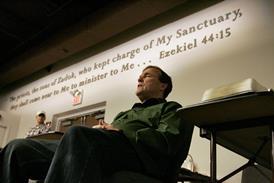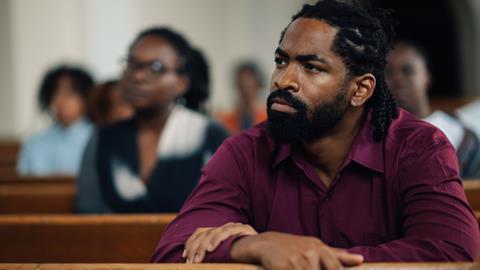Dr Belle Tindall asks why the ‘feminine’ way of knowing Jesus is considered the ‘worse’ way – and asserts that there shouldn’t even be a ‘feminine’ way in the first place!
I read an article recently, which was originally published by the New York Post and later picked up by The Telegraph, about the interesting rise in people becoming Orthodox Christians – particularly in America. Particularly, it seems, men.
Firstly, let me say – I love that this is happening.
Some of the most important and shaping conversations I’ve ever had about my faith, I’ve had with Christians from the Orthodox tradition. Once, while I was in the Middle East, I spent a whole week with the most amazing group of Oriental Orthodox Christians. It changed my life.
It’s a resilient tradition, a sensory tradition, a mystical tradition, a humble tradition. It’s brimming with beauty. And so, I really am overjoyed that people are being drawn to this particular expression of Christianity. Long may it continue.
It wasn’t the premise of the article that sent my mind whirring, it was the headline:
“Young men leaving traditional churches for ‘masculine’ Orthodox Christianity in droves”
Do you notice anything in that headline? There, not-so subtly peeking through, is the idea that there are masculine and feminine ways to know and love Jesus. But, more than that, it is implying that the so-called ‘feminine’ ways are inferior.
Certain forms of Christianity have always been somewhat looked down upon
The article quotes Father Josiah Trenham, who leads Saint Andrew’s Orthodox Church in Riverside, California. He says that: “The feminization of non-Orthodox forms of Christianity in America has been in high gear for decades” – pointing to “emotional songs, swaying, uplifted hands, and eyes closed in ecstasy”. He notes that, in contrast, “our (Orthodox) worship forms are very traditional and very masculine”.
Nothing new
Certain forms of Christianity have always been somewhat looked down upon; namely, the more charismatic kind. You know, the type that play ‘emotional songs’, allow ‘swaying’ and don’t think it’s weird if someone were to have ‘uplifted hands’ or ‘eyes closed in ecstasy’. The exact type of church I happen to go to.
It’s totally cool if that’s not your cup of tea. But the disdain toward this kind of church has always gone a little deeper than that. In his book, The Art of Losing Control: A philosopher’s search for ecstatic experience (Canongate Books), Jules Evans writes that these kinds of worship have continually been approached with “a mixture of amusement and horror” and regarded as “a regression to primitive irrationalism”. You see how strong those words are? What’s even more interesting is that he notes that this strand of Christianity has long been thought of as belonging to “women, the working class, ethnic minorities”. Why? Well, as Jules explains, it was thought that “these groups were naturally more unstable, emotional and credulous”.
That’s been the thinking since the Enlightenment. And both the New York Post and The Telegraph have just proved that it’s still very much the thinking now.
Why this thinking is wrong
So, there we have it: two ideas that I take slight issue with:
- That there’s a feminine and a masculine way to know and love Jesus
- That there’s a better and a worse way to know and love Jesus.
And, quite predictably, the ‘feminine’ way is considered the ‘worse’ way. Hence, men are fleeing from the ‘feminine’ churches in search of a more ‘masculine’ alternative. I’d like to quickly pour a bucket of water on the flames of this argument, if I may?
Maybe, just maybe, the way we engage with God isn’t solely tied up with our gender?
Firstly, it’s incredibly generalising to think that men and women can be squeezed into neat little ‘we-worship-this-way’ boxes. My dad is the most stereotypically ‘masculine’ man I know: he’s always worked in construction, he built the house I grew up in, he played rugby, goes to the gym every day…he ticks all the ‘macho’ boxes, right? And yet, he cries thinking about Jesus more than anyone I know (sorry Dad). You’ll regularly find him swaying, his arms tend to find themselves in the air, he can’t get enough of those ‘emotional songs’.
On the flip side, every week I attend a Eucharist service led and facilitated by the most amazing community of monastic Sisters. These women have completely given themselves over to being stretched and refined by life lived with Jesus; they are dedicated to fasting, to silence, to study, to service, to prayer, to community. What, apparently, we would call ‘masculine’ forms of worship.
Perhaps we’re not so easily categorizable, after-all? Maybe, just maybe, the way we engage with God isn’t solely tied up with our gender? Maybe it has more to do with our temperaments, our contexts, our stories. And so, maybe we don’t have to pick a lane?
And – my final maybe for you – maybe the Orthodox strand of Christianity is far more than the ‘masculine’ option?
Ultimately, this is a tale as old as time. Or, at least as old as the Enlightenment. Feminine equals emotional, and therefore, bad. Masculine equals rational, and therefore, better. And, honestly? I’ve run out of patience with it.

































1 Reader's comment